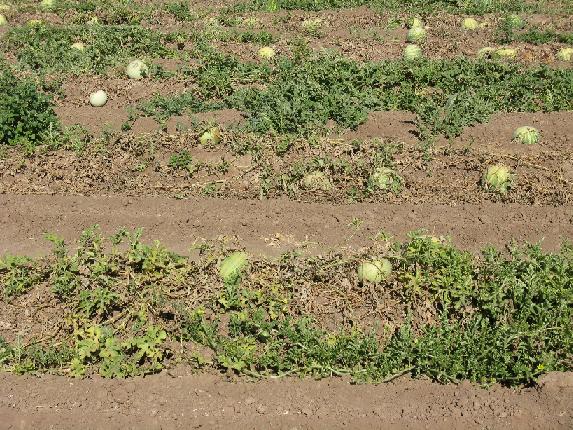 |
|
|
|

|
|||
| |
|||
In past years, fungal diseases such as Fusarium wilt, Charcoal rot, and Monosporascus root rot and vine decline have been implicated in the loss of melon plants this time of year in southwestern Arizona and southeastern California. This year, Pythium, a fungus-like plant pathogen, has been associated with significant losses of plants in several desert watermelon plantings. Several different Pythium species are found in agricultural fields. Pythium species can colonize melon feeder roots at any time; however, lateral root and taproot infections, which can lead to plant collapse and death, usually are observed following irrigations after fruit-set. Whether or not Pythium infections will proceed to cause melon plant damage or death is dependent on environmental factors such as soil temperature and moisture, and plant stress. With respect to temperature, some Pythium species can cause disease at low to moderate soil temperatures, whereas others are most active at higher temperature levels. All Pythium species thrive in very wet soil, as water is essential for production and spread of this pathogenís spores. Cultural factors that trigger disease development include fruit-load and late season water deficit stresses. In California greenhouse studies, melon plants growing in the presence of Pythium displayed symptoms of sudden wilt when the plants had set fruit and were subjected to a brief water stress period followed by flooding for 1 or 2 days. On the other hand, symptoms of sudden wilt did not occur when plants were maintained in a fruitless condition or were not subjected to a water stress period. Sudden wilt is occurring this year in many watermelon fields, where healthy-appearing plants suddenly collapse during the heat of the day, followed by permanent wilting and death a few days later. The onset and severity of sudden wilt will vary from field to field, with the speed of plant collapse associated with the degree and rate of root infection. Management considerations for sudden wilt caused by Pythium include careful irrigation water management and application of an effective fungicide such as mefenoxam (Ridomil Gold) at the first appearance of disease symptoms. Remember that other diseases, such as Fusarium wilt, Charcoal rot, and Monosporascus root rot and vine decline mentioned earlier, can cause similar symptoms; however, mefenoxam will have no effect on the fungal pathogens that cause these diseases. Pythium on Watermelons To contact Mike Matheron go to: matheron@ag.arizona.edu.
|
|||
| Back | |||
For questions or comments on any of the topics please contact Marco Pena at the Yuma Agricultural Center. |
|||
| Home | Cotton
| Veggies | Forages
| Grains | Citrus
| Crop x Crop Insects | Diseases| Weeds | Pesticides | Economics | News | Weather | Research | Photos | Contacts | General Info. Copyright © 2001 University of Arizona, College of Agriculture and Life Sciences Webmaster: Al Fournier (acis@ag.arizona.edu) |
|||
